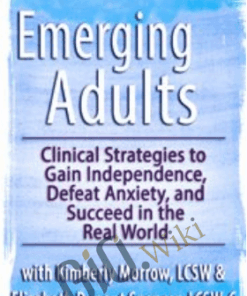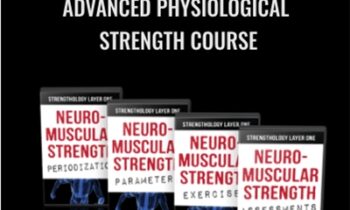$299.00 Original price was: $299.00.$74.00Current price is: $74.00.
Digital Download: You will receive a download link via your order email
Save up to 85% compared to Salepage prices. In addition, earn additional points. Save more on your next order.
Please contact email: wixzip.cs@gmail.com if you have any questions about this course.
 Purchase this course you will earn 74 Points worth of $7.40
Purchase this course you will earn 74 Points worth of $7.40Elevate your skills with the Arielle Schwartz, Megan McQuary & Melissa Westendorf – EMDR and Telehealth Mastery Course Advanced EMDR Trauma Treatments via Telehealth & In-Person course, available for just $299.00 Original price was: $299.00.$74.00Current price is: $74.00. on Utralist.com! Browse our curated selection of over 60,000 downloadable digital courses across diverse Health and Medical. Benefit from expert-led, self-paced instruction and save over 80%. Start learning smarter today!
 Arielle Schwartz, Megan McQuary & Melissa Westendorf – EMDR and Telehealth Mastery Course Advanced EMDR Trauma Treatments via Telehealth & In-Person
Arielle Schwartz, Megan McQuary & Melissa Westendorf – EMDR and Telehealth Mastery Course Advanced EMDR Trauma Treatments via Telehealth & In-Person
What if you could provide rapid treatments that remove blockages in your client’s brain so they can, once and for all, put the past in the past and heal from complex trauma, PTSD, chronic stress, fear and anxiety disorders?
By integrating EMDR therapy, you can unleash your potential to treat beyond traditional therapy methods.
Master EMDR therapy skills today and learn what thousands of clinicians have already discovered from our team of world-leading trauma and EMDR experts and their decades of intensive neuroscience research and clinical practice.
This self-study certification training will demystify EMDR and trauma’s impact on the brain and body, and guide you, step-by-step, through:
- The neuroscience of the EMDR 8-phase model
- Essential how-to steps to rewiring your client’s brain
- Somatic and parts work techniques to help your clients move forward
Not only will you gain neuroscience-based knowledge and tools needed to apply EMDR therapy immediately…
You’ll gain specific virtual EMDR therapy strategies for de-escalating trauma symptoms in a telehealth setting.
That’s not all: we’re so confident you’ll master EMDR for in-person therapy and telehealth delivery…
Session One
Arielle Schwartz, PhD, CCTP-II, E-RYT | Click here for information about Arielle SchwartzDiscover how you can more successfully access deeply rooted pain points and move clients past the internal conflicts that hang them up in treatment by integrating elements of EMDR with skills from a parts work approach.
You’ll learn:
- Nuances of stress, trauma, and complex PTSD
- The impact of dissociation
- Interpersonal neurobiology, somatic psychology, and social engagement
- The Polyvagal Theory
- Skill: Spacious, Relational Awareness
- Skill: Explore Co-Regulation
- Identify chronic, repeated, developmental and sociocultural trauma
- Overcoming betrayal trauma to resolve insecure attachment
- Assess for dissociation (“fragmentation”)
- How parts, ego states and defenses create walls to change
- Compassionate strategies for “Resistant” clients
- Move from shame to empowerment
- Skill: Understand emotional dysregulation as a “part”
- Skill: Connect to the adult self
- Skill: Differentiating from a part
- The 8 phases of EMDR therapy
- Neural networks and “encapsulated” ego states
- Bilateral stimulation and dual attention in EMDR therapy
- Modified EMDR therapy protocols
- Preparation for trauma reprocessing
- Cultivate mindfulness, acceptance, and self-compassion
- Skill: Choice and containment
- Skill: Build allies for a part of self
- Skill: Facilitate repair scenarios
- Skill: Reprocess a traumatic memory
- Skill: Positive state installation
- Trauma recovery and the bell curve
- Resilience as a process and an outcome
- Move from learned helplessness to learned optimism
- Skill: Create your resilience recipe
For more detailed information: Click here for course objectives and outline.
Session Two
Megan McQuary, LCSW, ACADC, CCTP-II, EMDR-C | Click here for information about Megan McQuary
- How EMDR can be used to overcome avoidance in clients
- How EMDR techniques can help clients resolve traumatic memories
- When and with which clients EMDR should be used
- How to emphasize safety during sessions
- How the 8-phase model is used in treatment
For more detailed information: Click here for course objectives and outline.
Trauma and Neuroscience
- Key brain areas involved in trauma
- Polyvagal Theory, and types of freeze responses
- Trauma and insecure attachment
- The neuroscience of developmental trauma
- Clinical implications of the freeze response
How the EMDR Approach Works
- The neuroscience of exposure therapy and cognitive therapy
- The neuroscience of relaxation exercises
- EMDR and other “transformative therapies”
- Why EMDR works so well from a brain perspective
Trauma Symptoms and Assessment Tools
- Traumatic memories and intrusive thoughts
- Phobias and anxiety: Insula hyperactivation
- Emotional hijackings and implicit memory
- Avoidance cluster of symptoms
- Why treating avoidance in trauma is critical
- DSM-5® symptoms in a nutshell
- Connecting to a diagnosis
- Simple vs. complex trauma
- Intergenerational trauma
- Symptom clusters and physical manifestations
- CAPS-5 and PCL-5
- Primary Care PTSD Screen
- Dual diagnosis
Overcome Avoidance with EMDR
- Dual awareness
- What you are thinking about is the network you’re in
- Activate networks for change
- Neurons that fire together, wire together (Hebb’s Rule)
- EMDR as neuroentrainment
When to Use EMDR in Treatment
- Demonstrations and experiential exercises
- Single event trauma
- Anxiety disorders involving imaginal exposure
EMDR Trauma Treatment: The Original 8-Phase Model
- Client history and treatment planning
- How to resource: Create a safe space
- Assessment: Choose a target, SUDS, connect with the image/emotions/thought
- Desensitization: Tactile vs. auditory vs. eye movement
- How to use touchpoints, Theratapper, CDs
- Positive Cognition Installation: Likert scale 1-7
- Body Scan: Locate tension and distress in the body
- Closure: Close the neural network and the 6-hour window
- Re-evaluation
Demonstration of Original 8-Phase Model
- Presenter demonstration
- Attendee dyad practice of the 8-phase model
EMDR Techniques to Resolve Traumatic Memories
- Modifications for Complex/Developmental Trauma
- Do not use standard protocol – Rationale for modifications
- Resourcing strategies
- Techniques to reinforce and activate positive neural networks
- Relevance of Polyvagal Theory, early trauma, and EMDR
- Sensory motor modifications and somatic approaches
- How to build Dual Awareness
- EMDR techniques to bring traumatic memories from the limbic system into the prefrontal cortex
Attachment-Based EMDR: Strategies to Treat Relational Trauma
- Strategies to foster the critical connection between client and therapist
- Mirror neuron activation
- How to emphasize safety during sessions
- Guidance on order of operations
Research Limitations and Potential Risks
For more detailed information: Click here for course objectives and outline.
Session Three
Megan McQuary, LCSW, ACADC, CCTP-II, EMDR-C | Click here for information about Megan McQuaryMaster EMDR and then follow this how-to guide on utilizing EMDR through telehealth platforms so you can continue your important work with clients, even when face-to-face sessions aren’t possible!
You’ll get safe, simple and straightforward approaches to adapting EMDR techniques to an online environment so you can stay on the front lines with your clients during times of crisis.
EMDR has been found to be effective when delivered virtually, and now you can get the answers to your most pressing questions:
- How do I manage potential safety risks when I’m not there in person?
- How can I monitor and manage reactions with clients online?
- How do I maximize attunement through video sessions?
Sale Page: https://catalog.pesi.com/sales/bh_c_001454evg_emdrtelehealth_organic-182547
Archive: https://archive.fo/wip/S6poh
Cultivate continuous growth with the Arielle Schwartz, Megan McQuary & Melissa Westendorf – EMDR and Telehealth Mastery Course Advanced EMDR Trauma Treatments via Telehealth & In-Person course at Utralist.com! Unlock lifetime access to premium digital content, meticulously designed for both career advancement and personal enrichment.
- Lifetime Access: Enjoy limitless access to your purchased courses.
- Exceptional Value: Benefit from savings up to 80% on high-quality courses.
- Secure Transactions: Your payments are always safe and protected.
- Practical Application: Gain real-world skills applicable to your goals.
- Instant Accessibility: Begin your learning journey immediately after buying.
- Device Compatible: Access your courses seamlessly on any device.
Transform your potential with Utralist.com!
Related products
Health and Medical
= 43 Points
Health and Medical
= 34 Points
Health and Medical
= 18 Points
Health and Medical
= 43 Points
Health and Medical
= 72 Points
Health and Medical
“Male Physique Training Templates” – Renaissance Periodization
= 42 Points
Health and Medical
= 43 Points
Health and Medical
= 35 Points




 Arielle Schwartz, Megan McQuary & Melissa Westendorf – EMDR and Telehealth Mastery Course Advanced EMDR Trauma Treatments via Telehealth & In-Person
Arielle Schwartz, Megan McQuary & Melissa Westendorf – EMDR and Telehealth Mastery Course Advanced EMDR Trauma Treatments via Telehealth & In-Person






